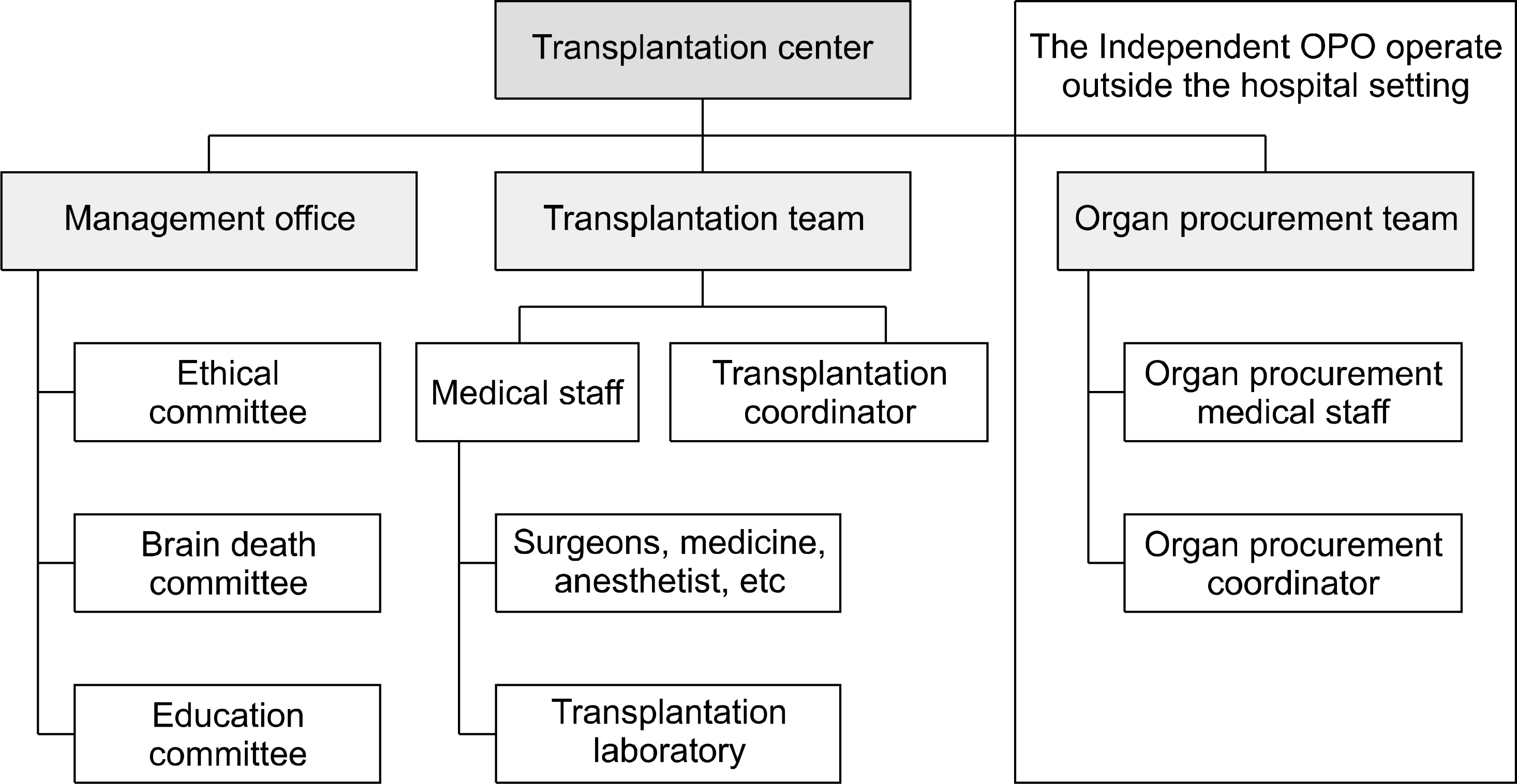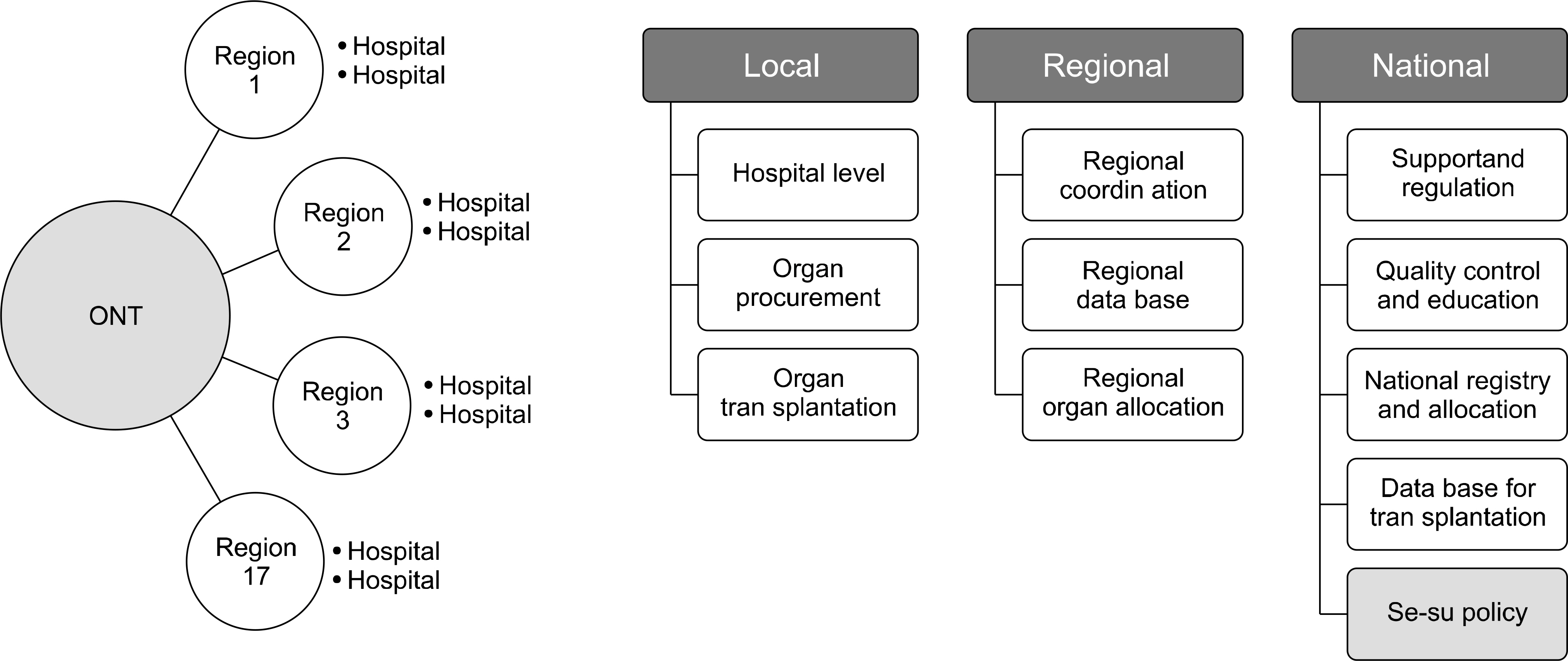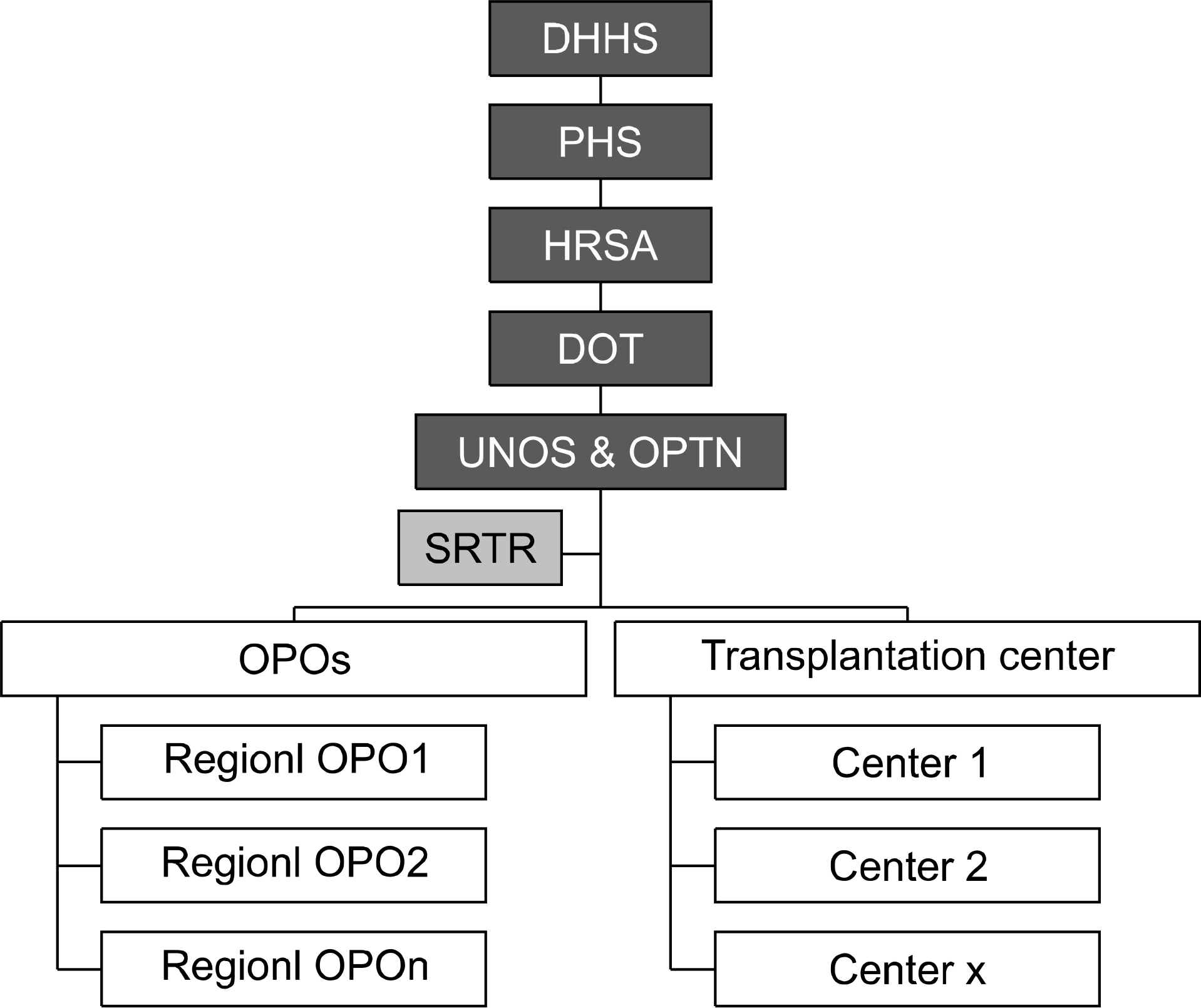Operational and Regulatory System Requirements for Pursuing Self-sufficiency in Deceased Donor Organ Transplantation Program in Korea
- Affiliations
-
- 1Transplantation Center, Seoul National University Hospital, Seoul, Korea. curie@snu.ac.kr
- 2Department of Internal Medicine, Seoul National University College of Medicine, Seoul, Korea.
- 3Department of Surgery, Seoul National University College of Medicine, Seoul, Korea.
- 4Vitallink, Seoul, Korea.
- 5Department of Internal Medicine, Eulji University School of Medicine, Seoul, Korea.
- 6Korean Network for Organ Sharing, Seoul, Korea.
- 7Department of Surgery, Yonsei University College of Medicine, Seoul, Korea.
- 8Keimyung University School of Medicine, Daegu, Korea.
- KMID: 1464307
- DOI: http://doi.org/10.4285/jkstn.2010.24.3.147
Abstract
- Since beginning with the first organ transplantation from brain-dead donor in 1979, organ transplantation has been developing continuously in Korea. However, organ shortage still is a serious problem in the field of solid organ transplantation. For this reason, it is necessary to promote deceased donor organ transplantation and achieve self sufficiency. There are two system requirements managing deceased donor organ transplantation; operational and regulatory systems. In operational system, mutual and balanced cooperation between transplantation centers, organ procurement organism (OPO), registration/allocation system and NGOs is one of most important determinants to maximize brain dead donor. Especially, transplantation center and OPO need to improve in their organ donation process through evaluating donation practices and developing critical pathway for each step. In addition, public education program focusing on the hospital staff, the family of deceased donors and students should be enhanced to increase public awareness for organ donation. In regulatory system, national transplantation authority for the transplant coordination among various structures and policy-making on the issue of organ donation is necessary. For this purpose, Korean Network for Organ Sharing (KONOS) has to be improved into professional and authoritative body and establish more expanded national database network system. Further improvement in operational and regulatory systems to activate organ donation could enable to achieve the Asian leadership in the field of transplantation as well as self sufficiency for organ transplantation.
MeSH Terms
Figure
Cited by 8 articles
-
Recent Decrease in Organ Donation from Brain-Dead Potential Organ Donors in Korea and Possible Causes
Jin Park, Claire Junga Kim
J Korean Med Sci. 2020;35(13):e94. doi: 10.3346/jkms.2020.35.e94.Waiting Time for Deceased Donor Kidney Allocation in Korea: A Single Center Experience
Su Hyung Lee, Kyu Ha Huh, Hyung Soon Lee, Hyun Jung Kim, Myoung Soo Kim, Dong Jin Joo, Soon Il Kim, Yu Seun Kim
J Korean Soc Transplant. 2012;26(1):32-37. doi: 10.4285/jkstn.2012.26.1.32.Current System for Allocation of Deceased Donor Kidney Transplantation
Mina Kim, Seirhan Kim, Su Hyung Lee, Chang-Kwon Oh, Jun Bae Bang
J Korean Soc Transplant. 2017;31(3):143-149. doi: 10.4285/jkstn.2017.31.3.143.Management of brain-dead donors in Korea
Jin Joo
J Korean Med Assoc. 2014;57(2):137-142. doi: 10.5124/jkma.2014.57.2.137.A study on the performance of the Donation Improvement Program in Korea
Su Jin Heo, Yong Ho Ju, Eun Jeong Noh, Kyoung Min Kim, Yu Kyoung Son, Sun Woo Jung, Hyun Jin Kang, Jung Rim Lee, Won Hyun Cho, Jongwon Ha
Korean J Transplant. 2021;35(2):77-85. doi: 10.4285/kjt.21.0006.Analysis of the Potential Deceased Donors in the Neurosurgical Intensive Care Units of Korea
Samuel Lee, Curie Ahn, Il Kim Soon, Jong Han Duck, Hyun Cho Won
J Korean Soc Transplant. 2011;25(2):106-112. doi: 10.4285/jkstn.2011.25.2.106.Attitude Favorability towards Organ Donation in Family Members of Brain Dead Organ Donors
Jaeheon Lee, Jung Lee Won, Myeong Lee Jae
J Korean Soc Transplant. 2014;28(4):219-225. doi: 10.4285/jkstn.2014.28.4.219.Medical Expenses of the Family Members of Brain Dead Organ Donors and National Assistance
Jaeheon Lee, Jung Lee Won, Kyung Lee Na, Myeong Lee Jae
J Korean Soc Transplant. 2015;29(1):23-27. doi: 10.4285/jkstn.2015.29.1.23.
Reference
-
References
1). Cho WH, Kim SI, Kim MS, Ahn C, Bang KT, Jeon KO, et al. A proposal to activate organ donation: report of organ allocation study group. J Korean Soc Transplant. 2009; 23:8–14. (조원현, 김순일, 김명수, 안규리, 방기태, 전경옥, 등. 국내 장기기증 활성화를 위한 방안: Organ Allocation 연구회 보고서. 대한이식학회지 2009;23: 8–14.).2). Spanish National Transplant Organization (ONT) [Internet]. Asturias, Spain: ONT;2010. Available from:. http://www.ont.es/Paginas/default.aspx.3). United Network for Organ Sharing (UNOS) [Internet]. Richmond, VA: UNOS;2010. Available from:. http://www.unos.org.4). Korean Network for Organ Sharing (KONOS) [Internet]. Seoul: KONOS;2010. Available from:. http://www.konos.go.kr/jsp/front/m01/sub_02.jsp.5). Kwak JY. Brain death donor organ transplantation and Organ Transplantation Law in Korea. J Korean Soc Transplant. 2007; 21:1–3. (곽진영. 뇌사자 장기이식과 장기 등 이식에 관한 법률. 대한이식학회지 2007;21: 1–3.).6). Andersen KS, Fox DM. The impact of routine inquiry laws on organ donation. Health Affairs. 1988; 7:65–78.
Article7). Oh MS. A survey on the perceptions and attitudes of public and medical professionals on organ transplantation. Seoul: Research & Research;2009. (오민수. 장기기증에 대한 일반국민 및 의료인 인식조사 보고서. 서울: Research & Research;2009.).8). Rithalia A, McDaid C, Suekarran S, Myers L, Sowden A. Impact of presumed consent for organ donation on donation rates: a systematic review. BMJ. 2009; 338:a3162.
Article9). Rithalia A, McDaid C, Suekarran S, Norman G, Myers L, Sowden A. A systematic review of presumed consent systems for deceased organ donation. Health Technol Assess. 2009; 13(iii):ix-xi:. 1–95.
Article10). Lee SM, Lee YH, Kim SH, Kim SY. Study on perceptions and attitudes of Koreans on organ donation. J Korean Soc Transplant. 2003; 17:227–33. (이상목, 이영호, 김상호, 김성연. 장기기증에 대한 한국인(韓國人)의 인식 연구. 대한이식학회지 2003;17: 227–33.).11). Teja JL, Quesada A, Rabanal JM, Fleitas MG, Cotorruelo JG, Espadas FL. Organ donor management: review of 68 consecutive cases. Transplant Proc. 1991; 23:2490.12). Park YJ, Kang H, Kim EM, Shin WY, Yi NJ, Suh KS, et al. Establishment of active identification and management system for potential brain dead donors in Life-link Center. J Korean Soc Transplant. 2009; 23:43–51. (박양진, 강현진, 김은만, 신우영, 이남준, 서경석, 등. 생명 연결본부: 능동적인 잠재뇌사자 발굴신고 및 뇌사장기기증자 관리체계 구축. 대한이식학회지 2009;23: 43–51.).13). Lee SJ, Park JB, Lyo IU, Sim HB, Song SK, Kwon SC. The organ donation rates in the neurosurgical field: preliminary study in a single institute. J Korean Soc Transplant. 2009; 23:252–6. (이승진, 박준범, 여인욱, 심홍보, 송순경, 권순찬. 신경외과 영역에서 발생하는 장기 기증률: 단일병원에서의 예비연구. 대한이식학회지 2009;23: 252–6.).
Article14). Roels L, Cohen B, Gachet C, Miranda BS. Joining efforts in tackling the organ shortage: the Donor Action experience. Clin Transpl. 2002. 111–20.15). Min SI, Kim SY, Park YJ, Min SK, Kim YS, Ahn C, et al. Trends in deceased organ donation and utilization in Korea: 2000–2009. J Korean Med Sci. 2010; 25:1122–7.
Article16). DuBois JM, Anderson EE. Attitudes toward death criteria and organ donation among healthcare personnel and the general public. Prog Transplant. 2006; 16:65–73.
Article17). Lee SM. Korean's cultural perspective and ethics of transplantation. J Ethics Educ Stud. 2005; 8:241–59. (이상목. 한국인의 문화적 관점과 장기이식의 윤리. 윤리교육연구 2005;8: 241–59.).18). Sheehy E, Conrad SL, Brigham LE, Luskin R, Weber P, Eakin M, et al. Estimating the number of potential organ donors in the United States. N Engl J Med. 2003; 349:667–74.
Article19). Lee JA, Kim SY. The knowledge and attitude of medical students towards the organ donation. J Korean Soc Transplant. 2008; 22:120–9. (이진아, 김소윤. 원저: 뇌사자 장기기증에 대한 의과대학생의 지식과 태도 연구. 대한이식학회지 2008;22: 120–9.).20). Kim SI, Min SI, Huh KH, Bang KT, Ahn C, Cho WH. The role of NGO in deceased organ transplantation. J Korean Soc Transplant. 2010; 24:1–3. (김순일, 민상일, 허규하, 방기태, 안규리, 조원현. 뇌사자 장기이식 활성화를 위한 Non-Governmental Organization (NGO)의 역할과 중요성. 대한이식학회지 2010;24: 1–3.).
Article21). Spital A. Care of the potential organ donor. N Engl J Med. 2005; 352:1266–7.
Article22). The American Board for Transplant Certification (ABTC) [Internet]. Lenexa, Kansas: ABTC;2010. Available from:. http://www.abtc.net.23). Transplant Procurement Management (TPM) [Internet]. Barcelona, Spain: TPM;2010. Available from:. http://www.24). Manyalich M, Cabrer C, et al. Training the transplant procurement management (TPM) coordinator. Touraine JL, Traeger J, editors. Organ Shortage: the solutions. Dordrecht: Kluwer Academic Publishers;1995. p. 191–5.
Article25). Miranda B, Matesanz R, et al. Integrated ways to improve cadaveric donation. Touraine JL, Traeger J, editors. Organ Shortage: the solutions. Dordrechr: Kluwer Academic Publishers;1995. p. 179–90.26). Matesanz R, Miranda B, Felipe C. Organ procurement in Spain: impact of transplant coordination. Clin Transplant. 1994; 8:281–6.27). Miranda B, Vilardell J, Grinyó JM. Optimizing cadaveric organ procurement: the catalan and Spanish experience. Am J Transplant. 2003; 3:1189–96.
Article28). The Agence de la biomédecine (ABM) [Internet]. Saint- Denis La Plaine Cedex, France: ABM;2010. Available from:. http://www.agence-biomedecine.fr.29). The Eurotransplant International Foundation (EIF) [Internet]. CB Leiden, Netherlands: EIF: 2010. Available from:. http://www.eurotransplant.org.30). Han YJ, Lee YH, et al. A proposal of brain death donors management. Seoul: the Korea Institute for Health and Social Affairs;2003. p. 83–9. (한영자, 이연희, 등. 뇌사자 관리 활성화 방안. 서울: 한국보건사회연구원; 2003: 83–9.).31). Minister of Health & Welfare, National Medical Center, Korean Network for Organ Sharing (KONOS). 2008 Annual report of organ transplantation. Seoul: KONOS;2009. p. 74. 보건복지가족부, 국립의료원, 국립장기이식관리센터. (2008 장기이식통계연보. 서울: 국립장기이식관리센터; 2009: 74.).32). Cho WH, Kim HT, Lee HJ, Seo YM, Lee SD, Son EI, et al. Development of Korean model for independent Organ Procurement Organization. J Korean Soc Transplant. 2008; 22:109–19. (조원현, 김형태, 이현진, 서영민, 이상도, 손은익, 등. 지역 장기구득기관의 한국형 모델 개발. 대한이식학회지 2008;22: 109–19.).33). Donor Action [Internet]. Linden, Belgium: Donor Action;2010. Available from:. http://www.donoraction.org.34). Roels L, Spaight C, Smits J, Cohen B. Sustained impact of the Donor Action methodology on donation practices: a 7-year follow-up in 4 European countries: 756. Transplantation. 2008; 86(Suppl 2):265.35). Roels L, Wight C. Donor Action: an international initiative to alleviate organ shortage. Prog Transplant. 2001; 11:90–7.
Article36). Wight C, Cohen B, Beasley C, Miranda B, Deblander G. Donor action: a systematic approach to organ donation. Transplant Proc. 1998; 30:2253–4.
Article37). Roels L, Spaight C, Smits J, Cohen B. Critical care staff attitudes to organ donation impact on national donation rates: data from the Donor Action Database. Crit Care. 2009; 13(Suppl 1):P79.
Article38). Kim BS, Kim YS, Kim SI, Kim MS, Lee HY, Kim YL, et al. Outcome of multipair donor kidney exchange by a web-based algorithm. J Am Soc Nephrol. 2007; 18:1000–6.
Article39). Shafer TJ, Wagner D, Chessare J, Zampiello FA, McBride V, Perdue J. Organ donation breakthrough collaborative: increasing organ donation through system redesign. Crit Care Nurse. 2006; 26:33–42. 44–8;quiz 49.40). Shafer TJ, Wagner D, Chessare J, Schall MW, McBride V, Zampiello FA, et al. US organ donation breakthrough collaborative increases organ donation. Crit Care Nurs Q. 2008; 31:190–210.
Article41). Matesanz R, Marazuela R, Dominguez-Gil B, Coll E, Mahillo B, de la Rosa G. The 40 donors per million population plan: an action plan for improvement of organ donation and transplantation in Spain. Transplant Proc. 2009; 41:3453–6.
Article42). The Collaborative Transplant Study (CTS) [Internet]. Heidelberg, Germany: CTS;2010. Available from:. http://www.ctstransplant.org.43). Kim MS, Joo MK, Chang HK, Kim YS. A national database development for management in organ transplant recipients. J Korean Soc Transplant. 2007; 21:147–60. (김명수, 주만기, 장혜경, 김유선. 장기이식 환자의 이식 후 관리를 위한 국가 데이터베이스 구축 대한이식학회지 2007;21: 147–60.).44). Kim SC, Han DJ, Kim TH, Hong JJ, Ha HS, Kim H. Development of organ transplantation information system associated with hospital Order Communicating System (OCS) and Korean Networking for Organ Sharing (KONOS). J Korean Soc Transplant. 2001; 15:225–30. (김송철, 한덕종, 김태희, 홍정자, 하희선, 김훈. 병원 전산화시스템 및 한국 장기이식 정보관리시스템과 연계된 통합 장기이식 정보시스템 프로그램의 개발 대한이식학회지 2001;15: 225–30.).
- Full Text Links
- Actions
-
Cited
- CITED
-
- Close
- Share
- Similar articles
-
- Current Status of Deceased Donor Organ Recovery and Sharing in Korea
- Activation Policy for Brain-dead Organ Donation
- Optimal System for Deceased Organ Donation and Procurement in Korea
- Discard of organs is the Achilles heel of deceased donor organ transplantation program: a study of ethology and predictors of organ discard from South India
- Improving self-sufficiency in organ transplantation in Korea





